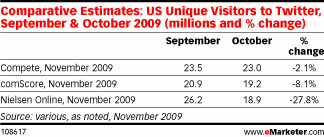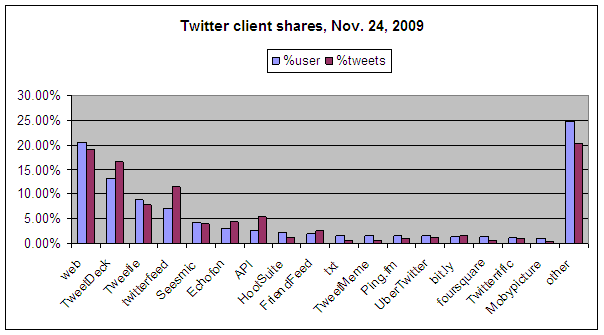
 The last 10 days have been pretty interesting to follow in the fast moving world of Twitter. They showed a contrasting (or seemingly so) picture of where the super-hyped company is heading. Let us rewind the last few events.
The last 10 days have been pretty interesting to follow in the fast moving world of Twitter. They showed a contrasting (or seemingly so) picture of where the super-hyped company is heading. Let us rewind the last few events.
The Retweet Button
The now infamous retweet button was introduced, then was removed, then was added back short after. But it is not so much the shakiness of the release that made the headlines as the disappointment felt by many users. From where I stand, the retweet button is a case-study of “how to botch a user-driven feature”. Retweets are part of the Twitter culture and serve to spread and reinforce information, but with a twist: the retweeter can put her own spin on the tweet. Not allowing editing the tweet removes half of the value of the feature.
Twitter’s usage (and value) decreased in October –or so it is claimed
Reports of Twitter’s usage dropping in October gave the doomsayers the opportunity to start the obituary of the service. Depending on the research firm, the number of unique US visitors from September to October dropped from 2.1% to a staggering 27.8% –the latest figure meaning that the number of unique US visitors dropped from 26.2 to 18.9 million unique visitors in October.
However the same report also mentioned an August 2009 study stating that 43% of Twitter users accessed the service through 3rd-party applications, and 19% through SMS. Thus a large chunk of the traffic is not accounted for. August is 3 months ago, which is about an eternity in Twitter’s world. Seesmic claims a 30%/month increase of its web traffic, which must translate into more users accessing tweets via their apps. Indeed, TwitStat reports that the twitter.com website, as of Nov 24th 2009, is responsible for only 19.09% of the tweets, via 20.51% of the Twitter users. Given the steady rise of Twitter 3rd-party applications from August to November, numbers based on Twitter.com traffic cannot be seriously interpreted. If anything, these numbers show that most of the people use Twitter clients other that the web site, and that the overall number of users did increase in October (about 19% of US Internet users in October 2009). By 2010 it is estimated that 26 millions people in the US will use Twitter.
In the same vein, NeXt Up Research calculated the value of Twitter to be between $526 million and $674 million –half of the $1 billion valuation the company got from its Sept 25 funding. The flaw though is that even if the study acknowledges that only 21% of the users access the service via the website, it fails to recognize that the value of the company comes from providing the tweets, regardless of the clients used to consume them.
Twitter goes all mobile: SMS and geolocation
The Nielsen Company reported that in Q3 2009, more than half of mobile Internet users accessed the Web via smartphones. This suggests that more and more people access Twitter via their phones, justifying using a 3rd party application to read tweets –there are plenty of well designed Twitter apps for iPhone, BlackBerry, and other smartphone owners.
Twitter continues its strategy towards substituting itself to SMS. After the agreement with Bharti Airtel in India, Twitter stroke a deal with Orange in UK, virtually replacing SMS for its users, for free. Increased traffic and more opportunities for future ads revenue and marketing research will be the payoff.
 And finally, Twitter released its geolocation API, opening the door to recommendations from locals, targeted marketing and promotional sales, and (real-time) search in your neighborhood. With Twitter data now being used by the three major search engines (Google, Microsoft, Yahoo), this promises a very valuable slice of a fast-growing market –look at Foursquare as an example to follow. Twitter co-founder Biz Stone said it all: “When we look at where we can grow we look to the more than 4 billion active mobile phone accounts in the world, opposed to the 1.65 million active web accounts.”
And finally, Twitter released its geolocation API, opening the door to recommendations from locals, targeted marketing and promotional sales, and (real-time) search in your neighborhood. With Twitter data now being used by the three major search engines (Google, Microsoft, Yahoo), this promises a very valuable slice of a fast-growing market –look at Foursquare as an example to follow. Twitter co-founder Biz Stone said it all: “When we look at where we can grow we look to the more than 4 billion active mobile phone accounts in the world, opposed to the 1.65 million active web accounts.”
Twitter to launch premium accounts
As expected, Twitter will start charging companies for premium access to the service in December 2009 or January 2010. These corporate accounts will provide thorough analytics to be used for customer prospecting, marketing campaign, customer service, and corporate image. More than half (56.3%) of marketers “realistically” plan to use social media (second only to email) in their 2010 campaigns, and 75% of them plan to increase social media tactics in their marketing strategy. Corporations are increasingly aware of the benefit of a good social media footprint. The top social networks proven to add marketing value are LinkedIn (26%), Facebook (23%), and Twitter (17%). Given the relatively small size of Twitter (LinkedIn has 50 millions users, and Facebook over 325 millions), it shows that the microblogging service provides a higher marketing and communication value per user. Thus it is clear that premium accounts will generate substantial revenues in the year to come.
Super tweet
 There have been a lot of discussions about how to monetize tweets, but not as much about how to enhance the quality of a tweet. The idea of a super tweet, carrying meta information, is coming along the needs for real-time search, categorization, and relevance. An application like speedi.ly allows fast, automated, classification of the URL carried with a tweet, which can be used to generate high-quality meta information that is easily searchable. A super tweet could also carry a payload that can be directly monetized, like promotional offers and coupons. As long as the scope of meta information is kept small and manageable, the applications for quality real-time search and push sales/marketing campaigns are immense.
There have been a lot of discussions about how to monetize tweets, but not as much about how to enhance the quality of a tweet. The idea of a super tweet, carrying meta information, is coming along the needs for real-time search, categorization, and relevance. An application like speedi.ly allows fast, automated, classification of the URL carried with a tweet, which can be used to generate high-quality meta information that is easily searchable. A super tweet could also carry a payload that can be directly monetized, like promotional offers and coupons. As long as the scope of meta information is kept small and manageable, the applications for quality real-time search and push sales/marketing campaigns are immense.
So what’s the verdict?
Twitter relies more and more on 3rd party apps to make its content available. There is nothing wrong with this, and some would argue it is a smart strategy –do not invest directly in how to distribute content, instead let the many startups compete for the price. However Twitter should make sure it can provide the content in a reliable manner. Also it should listen more to user requirements. Lists were a good addition, despite the lack of an efficient web interface to build them, but the retweet button limiting the user interaction is more than questionable. The idea of a super tweet, carrying meta information for accurate search and highly specialized promotional messages, will likely take root. The question is how fast Twitter will deliver on this.
Twitter is continuing its fast expansion in mobiles. Its support for geolocation will bring new targeted promotion tools, and all signs point to marketers and local businesses to use these features very soon. Twitter has proven to be a very efficient way of marketing a product or a brand, and it will keep developing new ways of refining target audience via search and push technology. The naysayers will quickly be shown that Twitter evolves faster than they expect, and the company will certainly capitalize on the economic recovery. Last but not least, Twitter is still being shaped by users as well as the profusion of innovative startups –the hottest Twitter service may still to be created.
Tell us what you think. Did Twitter reach a plateau, and is it just another fad that will eventually meet its fate? Or is it just the beginning, and it will be soon a must-have on any smartphone to communicate, share, promote, shop, and entertain?
Get the TNW newsletter
Get the most important tech news in your inbox each week.






